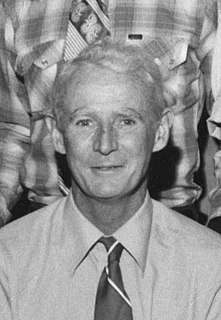
The Australian electoral system comprises the laws and processes used for the election of members of the Australian Parliament and is governed primarily by the Commonwealth Electoral Act 1918. The system presently has a number of distinctive features including compulsory enrolment, compulsory voting, majority-preferential instant-runoff voting in single-member seats to elect the lower house, the House of Representatives, and the use of the single transferable vote proportional representation system to elect the upper house, the Senate.

Electoral systems for the legislatures of the individual Australian states and territories are broadly similar to the electoral system used in federal elections in Australia.

The House of Assembly, or Lower House, is one of the two chambers of the Parliament of Tasmania in Australia. The other is the Legislative Council or Upper House. It sits in Parliament House in the state capital, Hobart.

A general election was held in the Northern Territory on Saturday 13 August 1977. Though the election was won by the incumbent Country Liberal Party (CLP), the party lost five of its seven executive members. Surprisingly, one of the casualties was Majority Leader Goff Letts—one of the few instances where a major-party leader at any level in Australia lost his own seat. The election also marked the emergence of the Labor Party as a parliamentary force: Labor took six seats in the new assembly.
Alice Springs was an electoral division of the Legislative Assembly in Australia's Northern Territory. One of the Legislative Assembly's original electorates, it was first contested at the 1974 election, and was named after the town of Alice Springs. It was abolished in 1983 and replaced by the new seats of Araluen, Braitling and Sadadeen.
Elsey was an electoral division of the Northern Territory Legislative Assembly in Australia. One of the original divisions, it was first contested in 1974 and was abolished in 1987. It was named after Elsey National Park. It was largely replaced by the new and considerably smaller electorate of Katherine, as population growth in the town of Katherine had resulted in the removal of much of the rural area of the electorate in the 1986 electoral redistribution.
Ludmilla was an electoral division of the Legislative Assembly in Australia's Northern Territory. One of the Legislative Assembly's original electorates, it was first contested at the 1974 election and was abolished in 1990. It was named after the Darwin suburb of Ludmilla.
Stuart Park was an electoral division of the Legislative Assembly in Australia's Northern Territory. One of the Legislative Assembly's original electorates, it was first contested at the 1974 election, and was abolished in 1983. It was named after the Darwin suburb of Stuart Park.
This is a list of electoral results for the Electoral division of Arnhem in Northern Territory elections.
This is a list of electoral results for the Electoral division of Barkly in Northern Territory elections.
This is a list of electoral results for the Electoral division of Casuarina in Northern Territory elections.
This is a list of electoral results for the Electoral division of Fannie Bay in Northern Territory elections.
This is a list of electoral results for the Electoral division of Nightcliff in Northern Territory elections.
This is a list of electoral results for the Electoral division of Port Darwin in Northern Territory elections.
This is a list of electoral results for the Electoral division of Sanderson in Northern Territory elections.
This is a list of electoral division results for the Northern Territory 1974 General Election in Australia.
This is a list of electoral division results for the Northern Territory 1977 General Election in Australia.

Hare-Clark is a type of single transferable vote electoral system of proportional representation used for elections in Tasmania and the Australian Capital Territory. The method for the distribution of preferences is similar to other voting systems in Australia, such as for the Australian Senate.
This is a list of electoral results for the Electoral division of Millner in Northern Territory elections.
This is a list of electoral results for the Electoral division of Victoria River in Northern Territory elections.



